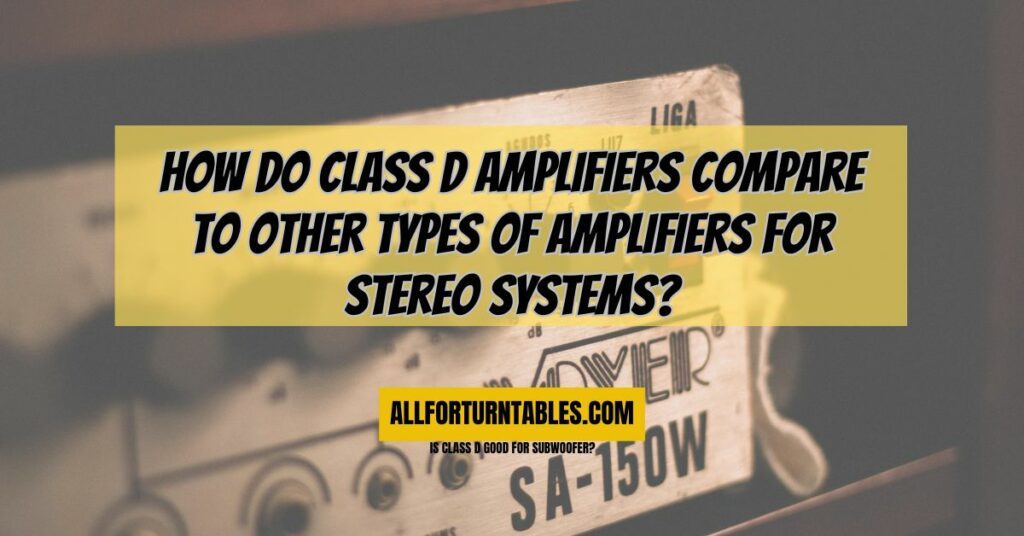Selecting the right amplifier is crucial for enhancing the audio quality of your stereo system. Amplifiers come in various classes, each with its own set of characteristics and strengths. Among these, Class D amplifiers have gained prominence for their efficiency and compact design. In this comprehensive comparison, we will explore how Class D amplifiers stack up against other types of amplifiers, such as Class A, Class AB, and Class H, for stereo systems. By the end of this article, you’ll have a clear understanding of the advantages and disadvantages of each amplifier class, helping you make an informed choice for your audio setup.
Understanding Amplifier Classes
Before we delve into the comparison, let’s briefly review the primary amplifier classes:
- Class A Amplifiers: Class A amplifiers are known for their linear operation. They continuously conduct current through their output transistors, resulting in high linearity and audio quality. However, they are notoriously inefficient and generate substantial heat.
- Class AB Amplifiers: Class AB amplifiers strike a balance between efficiency and audio quality. They combine the characteristics of Class A and Class B amplifiers and are widely used in consumer audio equipment.
- Class D Amplifiers: Class D amplifiers, also known as digital amplifiers, use Pulse-Width Modulation (PWM) to amplify audio signals. They are highly efficient and produce minimal heat, making them suitable for compact and energy-efficient designs.
- Class H Amplifiers: Class H amplifiers are a variation of Class AB amplifiers with voltage tracking. They adjust the supply voltage based on the input signal level, improving efficiency and reducing heat generation.
Comparison of Class D Amplifiers with Other Types
- Efficiency:
- Class D Amplifiers: Class D amplifiers are known for their exceptional efficiency, often exceeding 90%. This efficiency makes them ideal for applications where energy conservation and reduced heat generation are essential.
- Class A Amplifiers: Class A amplifiers are the least efficient, typically operating at about 20-30% efficiency. They consume a significant amount of power and generate substantial heat.
- Class AB Amplifiers: Class AB amplifiers offer moderate efficiency, typically around 50-70%. While more efficient than Class A, they still produce noticeable heat.
- Class H Amplifiers: Class H amplifiers offer improved efficiency compared to Class AB, thanks to their voltage tracking technology. Efficiency levels can reach around 70-80%.
- Sound Quality:
- Class D Amplifiers: Modern Class D amplifiers can rival the sound quality of Class AB amplifiers. Their switching technology has advanced to the point where they offer excellent clarity and precision.
- Class A Amplifiers: Class A amplifiers are renowned for their high-quality sound and linear performance. Audiophiles often prefer them for their warm and natural sound signature.
- Class AB Amplifiers: Class AB amplifiers strike a balance between efficiency and audio quality, offering good sound reproduction for most applications.
- Class H Amplifiers: Class H amplifiers can deliver impressive audio quality, especially in high-power applications where efficiency is crucial.
- Size and Form Factor:
- Class D Amplifiers: Class D amplifiers are compact and lightweight, making them ideal for space-constrained installations, such as portable audio devices and car audio systems.
- Class A and Class AB Amplifiers: Class A and Class AB amplifiers are larger and heavier due to their continuous operation and heat dissipation requirements.
- Class H Amplifiers: Class H amplifiers can be more compact than Class A or Class AB amplifiers due to their improved efficiency.
- Heat Generation:
- Class D Amplifiers: Class D amplifiers generate minimal heat, which is a significant advantage in both small-scale and high-power applications.
- Class A and Class AB Amplifiers: Class A and Class AB amplifiers produce substantial heat, necessitating adequate ventilation and cooling.
- Class H Amplifiers: Class H amplifiers strike a balance between heat generation and efficiency, with reduced heat compared to traditional Class A and Class AB designs.
In conclusion, the choice between Class D amplifiers and other types, such as Class A, Class AB, or Class H, depends on your specific requirements and priorities. Class D amplifiers excel in efficiency and compactness while delivering excellent sound quality, making them a popular choice for modern stereo systems. However, for audiophiles who prioritize the warm and natural sound signature of Class A amplifiers or those seeking a balance between efficiency and audio quality with Class AB or Class H amplifiers, the decision ultimately comes down to personal preferences and system requirements. Understanding the strengths and weaknesses of each amplifier class is essential to making an informed choice that best suits your stereo system’s needs.


